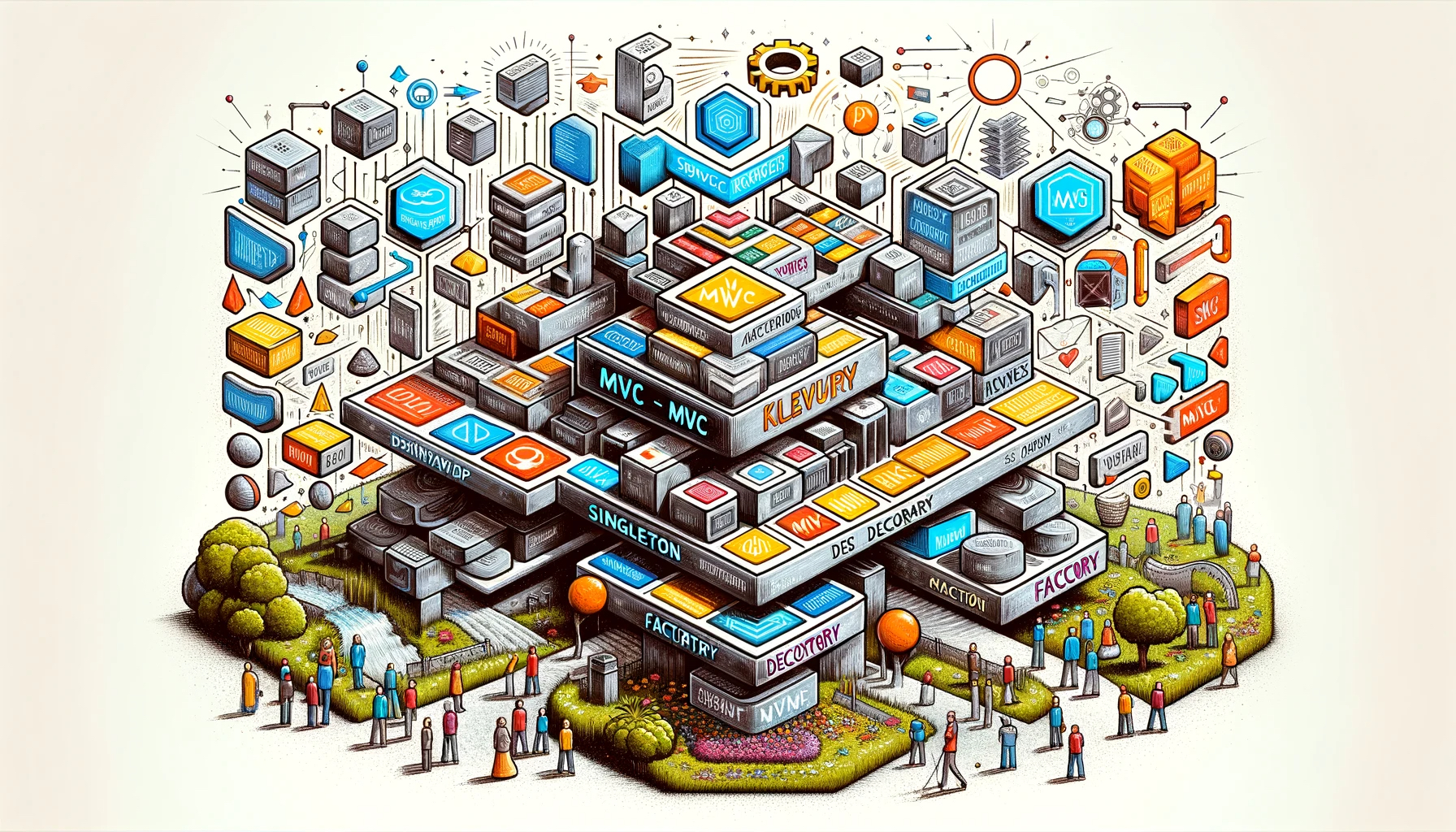Modern Software Development: Architecture Paradigms Design And Cloud-Native
原创Modern Software Development: Architecture Paradigms Design And Cloud-Native
原创
Overview
In today's rapidly evolving software industry, building efficient, maintainable, and scalable applications is of paramount importance. Let's explore several key concepts and methodologies that play a central role in modern software development.

Programming Paradigms: The Cornerstone of Software Development
In the world of programming, procedural programming stands as one of the oldest paradigms, emphasizing the execution of a program as a series of steps or procedures. This approach was prevalent in the past in single-board computers and early computer systems.
As software grew increasingly complex, Object-Oriented Programming (OOP) emerged, focusing on objects representing real-world entities as its central concept. OOP's four pillars—encapsulation, inheritance, polymorphism, and abstraction—made large-scale software development more manageable.
On the other hand, Functional Programming (FP), inspired by mathematical function concepts, emphasizes pure functions with no side effects and data immutability. Core principles of FP such as first-class functions and higher-order functions are gaining importance in modern development.
Software Architecture Patterns: Blueprints for Building Applications
With software systems becoming increasingly complex, a single programming paradigm could no longer meet the demands. This is when the concept of software architecture patterns came into play. MVC (Model-View-Controller) was one of the earliest architecture patterns used for graphical user interfaces, separating applications into three main parts and achieving separation of logic, data, and interface. Following that, MVP (Model-View-Presenter) and MVVM (Model-View-ViewModel) provided more flexible architectural solutions for complex user interface interactions.
Frontend and Backend Development: Divide and Conquer
As the internet rose to prominence, software development naturally divided into frontend and backend. Frontend development focuses on user interfaces and user experiences, utilizing technologies such as HTML, CSS, JavaScript, and various modern frameworks like React and Vue.js to create engaging web pages. In contrast, backend development revolves around server-side tasks, handling application logic, database interactions, user authentication, and utilizing technology stacks like Node.js, Ruby on Rails, and Django.
Internet software development is typically divided into two main parts: frontend and backend. The frontend, also known as the client-side, is the interface directly interacted with by users, including aspects like page layout, design, and animations. Modern frontend development frequently leverages various frameworks and libraries such as React, Angular, and Vue.js, providing a responsive and component-based development experience.
Conversely, the backend, or server-side, works behind the scenes, managing application logic, database interactions, user authentication, and more. Backend technology stacks encompass a wide range of languages and frameworks, including Node.js, Ruby on Rails, Django, and others.
Design Patterns: Optimizing Code Design
In the 1990s, design patterns became an essential branch of software engineering. Design patterns like Singleton, Factory, and Observer provide a mature set of solutions to common software design problems, aiding developers in writing clearer, maintainable, and reusable code.
The 12 Factors of Cloud-Native: Embracing the Era of Cloud Computing
Entering the 21st century, with the rise of cloud computing, the 12 Factors of Cloud-Native emerged, providing guiding principles for building more reliable, scalable, and maintainable applications on modern cloud platforms. These principles include best practices for managing codebases, declaring dependencies explicitly, configuration, logging, process management, and more, collectively defining the development approach for cloud-native applications.
From the foundational programming paradigms, through the blueprints of software architecture patterns, to the division of frontend and backend development, coupled with the refinement of design patterns, and finally reaching the forefront of cloud-native applications, this series of progressions not only showcases the evolution of technology but also represents a culmination of modern software engineering practices. This is the software development world we see today—a field filled with challenges and opportunities. By combining these concepts and practices, modern software developers can build applications that not only meet current demands but also adapt to future changes. Whether it's implementing microservices in a cloud-native architecture or applying the latest frontend frameworks in client applications, these principles and patterns provide a blueprint for success.
Terminology Explanation
Software Architecture Patterns
A set of classic solutions formed to address recurring problems in software engineering. Here is a brief analysis of three design patterns: MVC, MVP, and MVVM.
- MVC (Model-View-Controller)
Historical Development: MVC was first proposed by Trygve Reenskaug in 1979 while working at Xerox PARC for the Smalltalk-80 programming environment. This pattern aims to separate concerns, detaching the user interface data and business logic for simpler application management and maintenance.
Monolithic to Distributed Applications: MVC is highly suitable for monolithic applications, promoting internal responsibility separation. However, as applications evolve into Service-Oriented Architecture (SOA) or distributed applications, MVC boundaries may blur, as components in distributed systems often need to play multiple roles.
Future Trends: With the trend of front-end and back-end separation, MVC remains popular, especially in client-side frameworks. Modern variants might merge controllers and views, or redefine their roles in microservices architectures.
- MVP (Model-View-Presenter)
Historical Development: MVP, a variant of MVC, first appeared in the 1990s. It primarily addresses issues in certain GUI applications with MVC, like tight coupling between view and model.
Monolithic to Distributed Applications: MVP is suitable for complex UI applications, especially those needing separation of UI logic from business logic. It doesn't transition to distributed applications as naturally as MVC but remains favored in certain client frameworks.
Future Trends: MVP may persist due to needs for clearer separation and test-driven development demands, particularly in enterprise applications and complex desktop programs.
- MVVM (Model-View-ViewModel)
Historical Development: Introduced by Microsoft in 2005 for the .NET framework's WPF, MVVM aims to further reduce coupling between view and model, allowing simpler unit testing.
Monolithic to Distributed Applications: MVVM fits modern web and mobile apps, reducing boilerplate through data binding and enabling richer client interactions. In distributed systems, MVVM aids in frontend modularity and maintainability.
Future Trends: Growing in popularity with reactive programming and componentized development, MVVM is adopted by many modern front-end frameworks like Angular, Vue.js, and React (though React has its variants).
Programming Paradigms
- Procedural Programming
Core Concepts:
Procedures (Functions): Code blocks that perform specific tasks.
Modularity: Breaking down a program into reusable, non-repetitive procedures.
Sequential Execution: Programs execute in the order of the code.
- Object-Oriented Programming (OOP)
Core Concepts:
Classes and Objects: Using classes as templates for objects.
Encapsulation: Hiding an object's internal state and implementation details.
Inheritance: Deriving new classes to inherit features from existing ones.
Polymorphism: Different classes of objects can be operated through the same interface.
- Functional Programming (FP)
Core Concepts:
First-Class Functions: Functions treated as first-class citizens, assignable to variables, and usable as arguments and return values.
Immutability: Data is immutable, avoiding issues from state changes.
Pure Functions: Output depends only on input parameters, free from side effects.
Higher-Order Functions: Functions that take other functions as arguments or return them.
Programming Paradigm | Advantages | Disadvantages |
|---|---|---|
Procedural Programming | Simple to understand and implement; Suitable for small projects and simple applications | Difficult to manage complex and large codebases; Lower code reusability; Scattered state management, prone to errors and data inconsistencies |
Object-Oriented Programming | Easier to manage large applications, enhances code reuse; Improves maintainability and scalability | Can lead to over-engineering, increasing system complexity; Possible performance penalties |
Functional Programming | Often more concise and easier to reason about; Facilitates concurrent programming; Easier unit testing and debugging | Steeper learning curve; May not be as intuitive for certain problems |
Design Patterns
In software engineering, design patterns are standard solutions to common problems. They are categorized into three main types: Creational, Structural, and Behavioral. Here are some common patterns in each category:
- Creational Design Patterns
- Singleton: Ensures a class has only one instance and provides a global access point.
- Factory Method: Defines an interface for creating an object in a superclass but allows subclasses to alter the type of objects that will be created.
- Abstract Factory: Creates an interface for creating families of related or dependent objects without specifying their concrete classes.
- Builder: Allows constructing complex objects step by step, often using a director class to control the building process.
- Prototype: Creates new objects by copying an existing object, rather than creating new through new.
- Structural Design Patterns
- Adapter: Allows incompatible objects to collaborate.
- Bridge: Separates an abstraction from its implementation so that the two can vary independently.
- Composite: Lets you compose objects into tree structures to represent part-whole hierarchies.
- Decorator: Adds new functionalities to an object dynamically.
- Facade: Provides a simplified interface to a library, a framework, or any other complex set of classes.
- Flyweight: Uses sharing to support large numbers of fine-grained objects efficiently.
- Proxy: Provides a placeholder for another object to control access to it.
- Behavioral Design Patterns
- Chain of Responsibility: Lets you pass requests along a chain of handlers. Upon receiving a request, each handler decides either to process the request or to pass it to the next handler in the chain.
- Command: Turns a request into a stand-alone object that contains all information about the request.
- Interpreter: Given a language, define a representation for its grammar and a interpreter that uses the representation to interpret sentences in the language.
- Iterator: Provides a way to access the elements of an aggregate object sequentially without exposing its underlying representation.
- Mediator: Encapsulates how a set of objects interact.
- Memento: Without violating encapsulation, captures and externalizes an object's internal state so that the object can be restored to this state later.
- Observer: Lets one or more observers be notified and updated automatically when a subject's state changes.
- State: Lets an object alter its behavior when its internal state changes. It appears as if the object changed its class.
- Strategy: Defines a family of algorithms, encapsulates each one, and makes them interchangeable.
- Template Method: Defines the skeleton of an algorithm in the superclass but lets subclasses override specific steps of the algorithm without changing its structure.
- Visitor: Lets you separate algorithms from the objects on which they operate. These design patterns are widely applied in software development to address specific design issues or simplify the design process. They are not rigid rules but templates to guide and optimize design decisions.
Cloud-Native Twelve-Factor Methodology
The Cloud-Native Twelve-Factor App is a set of methodologies aimed at providing guidance for building scalable online applications, particularly suited for applications built and run on cloud platforms. Here's an overview of the Cloud-Native 12-Factor App:
- Codebase: One codebase tracked in version control, many deploys.
- Dependencies: Explicitly declare and isolate dependencies.
- Config: Store config in the environment.
- Backing Services: Treat backing services as attached resources.
- Build, release, run: Strictly separate build and run stages.
- Processes: Execute the app as one or more stateless processes.
- Port binding: Export services via port binding.
- Concurrency: Scale out via the process model.
- Disposability: Maximize robustness with fast startup and graceful shutdown.
- Dev/prod parity: Keep development, staging, and production as similar as possible.
- Logs: Treat logs as event streams.
- Admin processes: Run admin/management tasks as one-off processes. Adhering to these principles helps developers build adaptable, scalable, maintainable applications, decoupled from underlying hardware. Cloud-native applications are typically more flexible and can fully leverage the benefits of modern cloud computing environments.
原创声明:本文系作者授权腾讯云开发者社区发表,未经许可,不得转载。
如有侵权,请联系 cloudcommunity@tencent.com 删除。
原创声明:本文系作者授权腾讯云开发者社区发表,未经许可,不得转载。
如有侵权,请联系 cloudcommunity@tencent.com 删除。